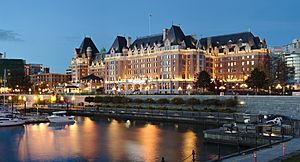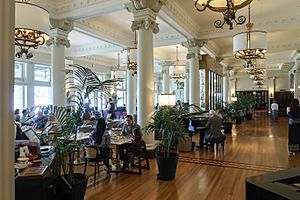The Empress (hotel) facts for kids
| Fairmont Empress | |
Quick facts for kids  |
|
| Hotel facts and statistics | |
|---|---|
| Location | 721 Government Street Victoria, British Columbia V8W 1W5 |
| Coordinates | 48°25′19″N 123°22′05″W / 48.42185°N 123.36797°W |
| Opening date | 20 January 1908 |
| Developer | Canadian Pacific Railway |
| Architect | Francis Rattenbury |
| Management | Fairmont Hotels and Resorts |
| Owner | Bosa Development |
| No. of restaurants | 4 |
| No. of rooms | 412 |
| of which suites | 52 |
| No. of floors | 8 |
| Footnotes | |
| Official name: Empress Hotel National Historic Site of Canada | |
| Designated: | 15 January 1981 |
The Fairmont Empress, often called The Empress, is one of the oldest and most famous hotels in Victoria, British Columbia, Canada. It sits at 721 Government Street in Downtown Victoria. The hotel faces Victoria's beautiful Inner Harbour.
The hotel was designed by Francis Rattenbury. It was built by Canadian Pacific Hotels, which was part of the Canadian Pacific Railway company. Today, Fairmont Hotels and Resorts manages the hotel. Since 2016, Fairmont has been part of AccorHotels. The hotel is owned by Nat and Flora Bosa from Vancouver.
The Fairmont Empress opened on January 20, 1908. Its unique style, called Châteauesque, makes it look like a grand castle. It is known as one of Canada's grand railway hotels. The hotel has been made bigger twice, first from 1910 to 1912, and again in 1928. In January 1981, the building became a National Historic Site of Canada. Between 2015 and 2017, the Empress had a huge makeover that cost over $60 million. The hotel celebrated its new look on June 28, 2017.
Contents
Where is the Fairmont Empress Located?

The Fairmont Empress is at 721 Government Street. It's at the south end of Downtown Victoria, which is the main part of the city. The hotel property is surrounded by Humboldt Street to the north, Belleville Street to the south, and Government Street to the west.
To the east of the hotel is the Victoria Conference Centre. This conference center is connected to the hotel by a special walkway built in 1989. The hotel also provides food and drinks for events at the conference center. Both the conference center and the hotel are bordered by Douglas Street on the east.
The hotel is very close to the British Columbia Parliament Buildings, where the government meets. It's also right by the city's Inner Harbour. This harbour is a big tourist spot and is west of the hotel, just across Government Street. Other fun places nearby include the Maritime Museum of British Columbia and the Victoria Bug Zoo. Both are north of the hotel, across Humboldt Street.
The hotel building was named a National Historic Site of Canada by Parks Canada. It received this special title on January 15, 1981. This was because of its important role in showing off the Châteauesque style of architecture.
What Does the Empress Look Like?
Hotel Architecture and Style
After buying the land, Canadian Pacific Hotels decided to build a new hotel. They wanted it to be like their other "grand railway hotels," which were built in the Châteauesque style. This style makes buildings look like French castles. Francis Rattenbury designed the hotel, and it was built from 1904 to 1908.
Rattenbury's first ideas included a seven-story hotel. It was meant to be similar to the Château Frontenac in Quebec City. His designs featured a huge entrance hall and a glass-roofed garden. However, after some delays, Rattenbury was replaced as the main architect on December 5, 1907. William Sutherland Maxwell, the chief architect for Canadian Pacific Railway, took over.
Like most Châteauesque hotels, the Empress uses stone and brick. It has steep copper roofs, fancy Gothic-style windows (called dormers), and pointed gables. It also has round towers (called turrets). The hotel's design also includes parts from other building styles. For example, the porch has Tudor architecture elements. The main roof is flat on top with iron railings, like the Second Empire style. The building isn't perfectly symmetrical. Inside, it has arched walkways and windows that stick out (called oriel windows).
The Empress has been made bigger twice since it first opened. William Sutherland Maxwell designed the first expansion from 1910 to 1912. The second expansion was finished in 1928. For many years, ivy plants covered much of the hotel's brick outside. But during renovations from 2014 to 2017, the ivy was removed. This was done to protect the bricks from damage and to stop animals from living in the plants.
Hotel Features and Services

The Empress hotel has 464 guest rooms and suites. These rooms are located all throughout the hotel building.
The hotel also has several places to eat and drink. These include the Lobby Lounge, Q at the Empress Restaurant, and the Q Bar. All these restaurants were updated in 2017 by a design company called Puccini Group. The dining areas now have purple hardwood floors and unique chandeliers made of textured fabric. The hotel's famous afternoon tea service is held in the Lobby Lounge.
The Willow Stream Spa is a special place inside the hotel for relaxation. It has a Finnish sauna, a steam room, and a mineral pool. The hotel also has a fitness centre with an indoor swimming pool and a hot tub.
A Brief History of the Empress Hotel
Francis Rattenbury designed the Empress for Canadian Pacific Hotels. It was meant to be a hotel for people arriving by Canadian Pacific's steamship line. The main ship terminal was only a block away. The hotel was built for business travelers and visitors to Victoria. Later, as Canadian Pacific stopped its passenger ship services, the hotel became popular with tourists. Victoria started to become a big tourist spot in the mid-to-late 1920s.
The hotel was built between 1904 and 1908, opening that year. More parts were added between 1909 and 1914, and again in 1928. In 1919, Edward, Prince of Wales (who later became King) attended a fancy party in the hotel's Crystal Ballroom.
In the 1930s, child star Shirley Temple stayed at the hotel with her parents. There were rumors that she had left California because of kidnapping threats. This story came from the two large bodyguards who stayed in the room across from hers. They always left their door open. On May 30, 1939, King George VI and Queen Elizabeth had lunch at the Empress. This was during their 1939 royal tour of Canada.
Until 1960, the hotel did not have a sign above its front entrance. In 1965, there was talk about tearing down The Empress. Some wanted to build a more modern hotel in its place. But a local newspaper warned that without this "splendid relic of the Edwardian era," many tourists would not return. They called it the "Mecca" and the "heart and soul of the city." On June 10, 1966, the hotel's owners announced they would not tear it down. Instead, they would spend $4 million to fix it up. This project was playfully called "Operation Teacup."
In 1989, over $45 million was spent on another big renovation called "The Royal Restoration." Guest rooms were updated. A health club, an indoor swimming pool, and a new reception area were added. During these renovations, hotel staff found what seemed to be a tunnel. It ran from James Bay into the basement of the Empress. At high tide, saltwater would flood the opening in the basement. It's not clear what the tunnel was for. Some people think it was part of the hotel's old waste system. They believe that sewage from the hotel might have been flushed into James Bay at one time.
In 1999, Canadian Pacific separated its hotel business. The new company was renamed Fairmont Hotels & Resorts. This was to show that it was growing around the world. All former Canadian Pacific hotels were to be renamed with the "Fairmont" prefix. This caused a big upset in Victoria. People and newspapers were very unhappy, seeing it as disrespectful to the hotel's history. Even though the new name stuck, Fairmont did not change the original sign on the hotel's outside. This was a compromise to calm local worries and respect the hotel's heritage.
Fairmont later sold the hotel on October 31, 2000, to the Legacy Hotels REIT for CAD $120 million. However, Fairmont still manages the hotel with a long-term agreement. As of August 2005, Fairmont owned a small part of Legacy Hotels. The hotel was sold again on June 27, 2014, to Nat and Flora Bosa from Vancouver. They invested over $60 million in renovations. In May 2017, the first part of the restoration work was finished. These updates included new designs for the guest rooms, suites, spa, dining areas, and the main lobby.
Images for kids




